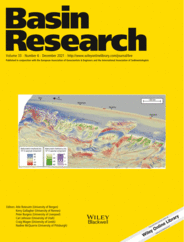
Full text loading...
 , Dewen Zheng3, Renjie Zhou2, Weitao Wang4, Jingxing Yu1, Caicai Liu1, Yizhou Wang1, Jianzhang Pang1, Yan Ma1, Yuqi Hao1, Youjuan Li1, Xueye Wang5
, Dewen Zheng3, Renjie Zhou2, Weitao Wang4, Jingxing Yu1, Caicai Liu1, Yizhou Wang1, Jianzhang Pang1, Yan Ma1, Yuqi Hao1, Youjuan Li1, Xueye Wang5
The development history of high topography in the northeastern (NE) Tibetan Plateau is essential to test various plateau growth models and understand plateau construction. We present integrated provenance data from the NE Qaidam Basin, south of the Qilian Shan. Results show an increase in carbonate lithics, an increase in Al2O3/SiO2 ratios, a negative shift in εNd values and an appearance of large amounts of Precambrian zircon grains in the period of ca. 13–8 Ma, arguing that the sediment source of the NE Qaidam Basin may have shifted from the East Kunlun Shan to the Qilian Shan during this time interval. We infer that significant topographic growth of the southern Qilian Shan occurred during the middle‐late Miocene. Along with widespread middle to late Miocene deformation records across the Qilian Shan and abruptly shifts on provenance, sedimentary facies and climate indexes in its surrounding basins, present high topography of the NE Tibetan Plateau may have been established since the middle‐late Miocene.
,Integrated provenance analysis in the NE Qaidam Basin reveal topographic growth of the southern Qilian Shan during the middle‐late Miocene, from a lower relief region at ca. 13 Ma to a higher relief region at ca. 8 Ma.

Article metrics loading...

Full text loading...
References


Data & Media loading...

